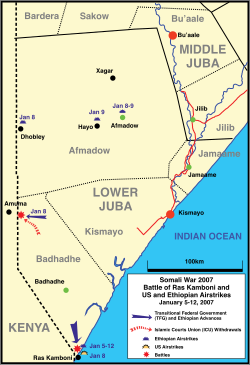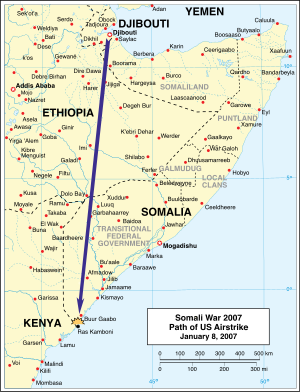2007 timeline of the War in Somalia
*The number includes policemen, militiamen and intelligence personnel**Other soldiers killed: 2 Kenyan, 6 Ugandan On January 1, Islamists abandoned their last stronghold in Kismayo.
[3] In a move to curb resistance against the come-back of the Interim government, after the take-over of Mogadishu on Friday, Ali Mohammed Gedi swiftly announced the introduction of martial law, but such a measure, taken on the background of what is seen as foreign occupation, is already sparking the organization of guerrilla warfare in the capital.
Reports said ICU troops were split across Afmadow and Badade districts, and possibly concentrated at the former Al-Ittihad Al-Islamiya (AIAI) stronghold of Ras Kamboni.
[17][18][19] On January 5, 2007, Sheikh Farah Moallim Mohamud became the highest-ranking member of the Islamic Courts Union (ICU) to be captured by the Ethiopian-Somali forces.
[20] On January 5, 2007, TFG Defense Minister Col. Barre Aden Shire Hiiraale announced: "Today we will launch a massive assault on the Islamic courts militias.
The clashes came after armed militiamen attacked military vehicles belonged to Ethiopian troops passing in front of the Sahafi hotel in southern Mogadishu.
[26] Prof. Ibrahim Hassan Addow, representative of the ICU, speaking from Yemen, said the Islamic Courts were ready to enter negotiations with the Transitional Federal Government.
[34] On January 9, 2007, seven Pakistani members of the Tabliq (Tablighi Jamaat) were arrested in Mogadishu near the Presidential Palace of Villa Somalia, causing a local protest.
[38] On January 10, 2007, due to the barrack attack, significant street fighting broke out in Mogadishu stretching from dawn to afternoon in a multi-party daylight clash between troops of the national government, Ethiopian soldiers, Islamic insurgents and local militias.
[citation needed] The verification of the death of Mohammed followed private comments made by US Defence Department officials that further airstrikes were possibly being planned.
[48] On January 12, TFG Defense Minister Barre Aden Shirre Hiiraale announced Ras Kamboni had fallen to the Somali government and Ethiopian forces after five days of heavy fighting.
[60] Also today, a U.S. official in a press conference said she believed the U.S. AC-130 raid had killed eight soldiers of Aden Hashi Farah Ayro, head of an Islamist militia.
[61] Also on that day, the Assistant Deputy Secretary of Defense for African affairs, Theresa Whelan, clarified the airstrike conducted on January 8 was not the work of the CJTF-HOA, but of another force which she did not specify.
The target of the strike was confirmed to be Aden Hashi Farah Ayro, who was believed wounded or possibly dead, while eight members of his group were killed in the attack.
[63] On January 19, 2007 the pro-Islamic Courts Union website featured a video describing the reformation of the ICU into the Popular Resistance Movement in the Land of the Two Migrations (PRM).
[74] On February 9, a gathering of 800 Somali demonstrators in north Mogadishu, where Islamist support was strongest, burned U.S., Ethiopian, and Ugandan flags in protest of the proposed peacekeeping mission.
A truce brokered by influential Hawiye-clan elders between the government and the Council of Islamic Courts failed to stop fighting that has left the streets of Mogadishu strewn with dead bodies.
The organization demanded Somalia's President Abdullahi Yusuf Ahmed, Ethiopian Prime Minister Meles Zenawi, and all armed groups to ensure that their forces strictly abide by international humanitarian law and take all necessary measures to protect civilians.
A missile hit a hospital ward, in Mogadishu, packed with civilians wounded in fighting between Islamic insurgents and Ethiopian troops allied to the Somali government.
[94] Clashes between U.S. backed-Ethiopian forces and fighters aligned with the Islamic Courts Union in the capital Mogadishu are being described as some of the heaviest fighting in the city's history.
[95] Human Rights Watch documented how Kenya and Ethiopia had turned the region into Africa's own version of Guantanamo Bay, replete with kidnappings, extraordinary renditions, secret prisons and large numbers of "disappeared".
Assailants believed to be members of armed groups opposed to Somalia's transitional government and its Ethiopian allies have killed four police officers in the capital, Mogadishu, in continued fighting described by human rights organisations as mostly affecting civilians.
At least one person was reported dead Friday in a small village in southern Somalia after tens of people rushed on a building where an aid agency was distributing food, witnesses said.
The United Nations' WFP aid agency was distributing food to refugee families in Kuntuwarey, a town in Lower Shabelle region.
The port town of Marka, provincial capital of Lower Shabelle, was relatively quiet all day Tuesday as people largely stayed inside their homes for fear of more armed clashes.
Gunmen shot dead Ahmed Hareed, a district official for Somali National Security Agency, overnight in the south of the lawless capital, the latest in a string of attacks targeting government employees and sympathisers.
Somalia's Northern regions, which until recently enjoyed a relative peace, are on the verge of entering an era of internecine clan warfare similar to, and may be worse than, what has plagued the southern part of the country for over a decade.
In Bossasso after a day-long stand-off gunfire erupted killing two suspected Islamic insurgents in Puntland and injuring four police officers, resulting in one of them dying in hospital.
[123] According to Human Rights Watch, Ethiopian forces backing the Somali transitional government violated the laws of war by widely and indiscriminately bombarding highly populated areas of Mogadishu with rockets, mortars and artillery.
[125] The United States had assisted Somali, Ethiopian and Kenyan forces with intelligence, advisors and limited military strikes from bases in those countries and from Djibouti.







